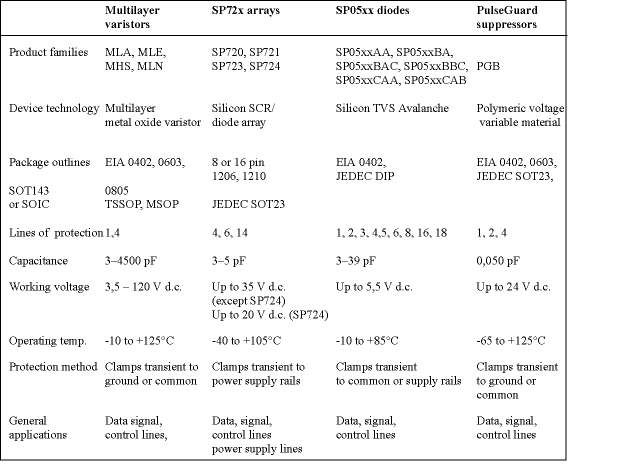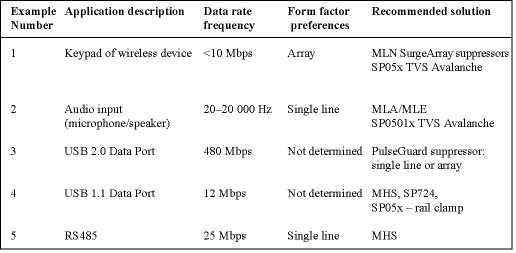
Littelfuse offers three device technologies for the suppression of ESD events and other EMC-related transients. These are the MultiLayer Metal Oxide Varistor, Silicon (SCR/diode array and TVS avalanche diode arrays) and Polymeric Voltage Variable Material technologies. Although these products have different characteristics, they have the common goal of protecting sensitive components from transients that threaten their survivability and functionality. Additionally, EMC legislation, or other immunity requirements, may mean that existing products require suppression devices in order to be compliant with the applicable immunity test.
As with all decision-making processes, information is the key when considering the use of ESD suppressors. It is critical that the circuit characteristics are defined. For example, the capacitance value of the ESD suppressor will limit its usage on communication lines. As the speed of the data increases, the capacitance (if it is too large) can distort or attenuate the data. Ideally, the design engineer will gather basic circuit information such as data rate, allowable leakage current, line voltage, size constraints, and number of lines that require protection. This information can then be used to compare the circuit conditions to the ESD suppressor characteristics to find the best 'match'.

To help with the matching process, a suppressor characteristic table is included (Table 1) and a selection flowchart (Figure 1).

Suppressor functional similarities
The unique features of each product family are used to define the applications (circuit conditions) for which they are best suited. While these technologies have different electrical and physical characteristics, they share many basic traits. In general terms, they do the following:
* Reduce the ESD voltage that is seen by the circuit in order to protect the data/signal/control lines.
* Are effective protection against fast rise-time ESD transients, such as those specified in IEC 61000-4-2. They are not applicable to ESD specifications such as charged device model (CDM), machine model (MM), or human body model (HBM). These three specifications are used to typify chip survival in the chip foundry and board manufacturing environments and reflect the built-in ESD protection of ICs and ASICs. They do not guarantee the survival of the chip during its lifetime in the end product. User-generated ESD events that will be seen by the chip in the end-product are much more severe and typically require the use of supplemental ESD suppression treatments (such as Littelfuse's ESD suppressors);
* Are bi-directional, working in [+] or [-] polarity circuits and suppressing positive and negative transients.
* Are rated for the most common board level operating voltages.
* Can often replace TVS Zeners (eg, 'Transorbs' or 'Mosorbs') while saving board space (eg, Littelfuse SP723/SP724 or ML series).
* Can often replace diode arrays or Zener arrays.

Selecting the ESD suppressor
The data protocols and transmission rates that are used in various applications (eg, cellphone, PDA, computer, etc) will help determine the applicability of ESD suppressors. As data rates increase, the amount of stray capacitance that the circuit can withstand, and yet still properly function, decreases. In turn, the capacitance of ESD suppressors becomes an important characteristic, and can be used as one criterion for their selection.
In short, at very low speeds (audio and keypad circuits), capacitance of the ESD suppressor is not an issue. In fact, the capacitance can often help minimise EMI noise acting like a low band pass filter. However, as speeds increase, capacitance plays an important role. Too much capacitance can cause degradation to the data signals and interfere with signal integrity. Therefore lower capacitance devices are necessary.
Lastly, note that other suppressor characteristics, for example leakage current, clamping level, number of channels, etc, will also need to be kept in mind when selecting the most appropriate suppressor for one's circuit.
For more information contact Littelfuse representative, Hi-Q Electronics, 011 420 2911, [email protected], or 021 595 1307, [email protected]

© Technews Publishing (Pty) Ltd | All Rights Reserved